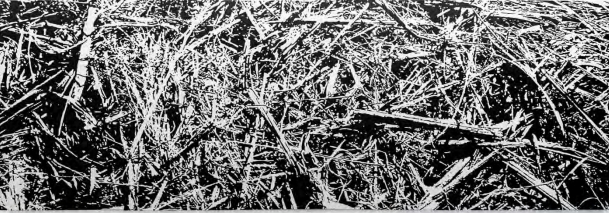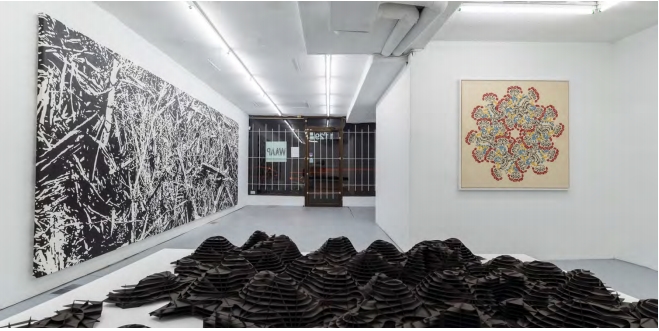WAAP 1129 East Hastings
Vancouver, BC V6A 1S3
+1 (778) 229 3458
http://www.waapart.com
Wil aballe art projects

As it was, as it should have been looks at two moments in Campbell’s art practice. Work produced between 2009-2012 draws from images of sugar production and Jamaica’s slavery/early post slavery carnival traditions. His more recent work projects the history of the Jamaican Maroons, escaped slaves that fought and won their autonomy from the British, into future possibilities.

Bagasse, 2009 Acrylic on panel 300” x 78”
Bagasse, a large 19 ft x 6.5 ft black and white painting of the trash left over after sugarcane cultivation dominates the largest wall of the exhibition space. Bagasse references the protocapitalist economy of the sugar plantation and acts as a metaphor for economic systems that view society and human relationships as bi-products. Actor Boy prints 1 & 2 provide a counterpoint to these capitalist degradations, refiguring an image from the Jamaican Christmastime carnival celebration, Junkanoo, into an elaborate floral motif.
Click on the first picture to see the diaporama

Actor boy IIi 2009Oil on canvas48x48

Actor boy II 2009Oil on canvas48x48

Actor Boy I 2009 Oil on canvas 48 x48

Actor boy IV2009Oil on canvas48x48

Actor boy Print1 2012 Sérigraphie édition limitée
Maroonscape 1: Cockpit Archipelago is a map inspired by Jamaica’s Cockpit Country, an area with hills, ridges, and deep valleys, where enslaved Africans and their descendants, known as Maroons, settled after escaping the plantations. Jamaican Maroons used the tough landscape of Cockpit Country as a natural defense against the colonizers. Maroonscape 1 reimagines Cockpit Country as a model for a city of the future—a place where resourcefulness, imagination, and community confront the temptations of power and complicity. Maroonscape 2: Yet Every Child translates the birdsong from species endemic to Cockpit country into an urgent message about growth, destruction and change from Octavia Butler.

Ma roonscape 1 Cockpit Archipelago 2019 Mat board and wood Edition of 3
Together these work takes on a journey of reinvention and searches for meaning amongst brutality, compromise and resilience.
Charles Campbell is a Jamaican-born multidisciplinary artist, writer and curator. His work investigates non-linear concepts of time and the future imaginaries possible in the wake of colonization using painting, performance, sculpture and installation. His work has been exhibited widely including at the Perez Art Museum Miami, Havana Biennial, the Brooklyn Museum, the Santo Domingo Biennial and Alice Yard in Port of Spain. Campbell holds an MA in Fine Art from Goldsmith College and a BFA from Concordia University. He currently lives and works in Victoria BC.
ABOUT THE WORKS
CHARLES CAMPBELL’s new work is a map inspired by his native Jamaica’s Cockpit Country, an area with hills, ridges, and deep valleys where enslaved Africans and their descendants, known as Maroons, settled after escaping the plantations. Jamaican Maroons used the tough landscape of Cockpit Country as a natural defense against the colonizers. Campbell sees Cockpit Country as a model for a Caribbean city of the fuuture—a place of resourcefulness, imagination, and community spirit.











Discussion
Pas encore de commentaire.